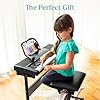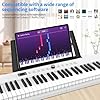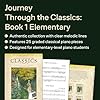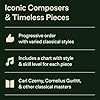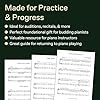Table of Contents
Introduction to Learning Piano Through Classical Music
The journey of learning piano can be extraordinarily rewarding, especially when merged with the rich depths of classical music. This approach not only enhances technical skills and musical knowledge but also deeply connects students with a centuries-old tradition of musical excellence. Through the disciplined study of classical compositions, learners develop precision, emotion, and a refined understanding of musical storytelling, setting a solid foundation for proficiency in piano playing.
Starting with Simple Classical Pieces for Beginners
Embarking on the journey of learning the piano through classical music involves starting with pieces that are approachable but foundational in technique and musicality. Here are several iconic yet simple pieces tailored for beginners:
Donner Digital Piano Keyboard Velocity-Sensitive 88 Keys with Removable Piano Stand, Compact Beginner Home Electric Piano with Split Mode, LED Digital Tube for Display, and Triple Pedal DEP-08
10% OffBest Choice Products 61-Key Electronic Keyboard Piano Portable Electric Keyboard Complete Beginner Set w/LED Screen, Stand, Bench, Headphones - Black
20% OffMARVTOWN 49-Key Roll Up Digital Piano Keyboard, Portable Electronic Piano with Rechargeable Battery, 8 Tones, 6 Demo Songs, Black and White, Perfect for Beginners and Practice
$45.99 (as of December 13, 2025 19:19 GMT -08:00 - More infoProduct prices and availability are accurate as of the date/time indicated and are subject to change. Any price and availability information displayed on [relevant Amazon Site(s), as applicable] at the time of purchase will apply to the purchase of this product.)88 Key Digital Piano, Semi Weighted Electronic Keyboard Piano with Music Stand, Power Supply, Sustain Pedal, Bluetooth, Carrying Case, Headphones, USB-MIDI Compatibility, for Beginner Professional
$109.99 (as of December 13, 2025 19:19 GMT -08:00 - More infoProduct prices and availability are accurate as of the date/time indicated and are subject to change. Any price and availability information displayed on [relevant Amazon Site(s), as applicable] at the time of purchase will apply to the purchase of this product.)Muzio Clementi’s Sonatinas are excellent for beginners to develop finger dexterity and understand classical sonata form, particularly the pieces from Op. 36. They begin very simply and gradually introduce more complex elements as the student progresses.
Bach’s Minuets, notably in G Major and G Minor, are staple teaching pieces in many beginner pianist’s repertoire. These pieces allow students to learn balanced phrasing and Baroque stylistic elements, making them crucial for early technical development.
Mozart’s Minuet in F is a delightful piece for beginners and is part of the small collection Mozart wrote as a child. This piece challenges the student with its dynamics and articulation, embodying classical elegance and charm.
Robert Schumann’s Album for the Young contains 43 manageable pieces that vary in mood and technical demand. No. 1, “Melody,” and No. 8, “Wild Rider,” are particularly popular among beginners, offering a mix of lyrical playing and more spirited, rhythmic work.
Redragon Mechanical Gaming Keyboard Wired, 11 Programmable Backlit Modes, Hot-Swappable Red Switch, Anti-Ghosting, Double-Shot PBT Keycaps, Light Up Keyboard for PC Mac
40% OffLogitech K270 Wireless Keyboard for Windows, 2.4 GHz Wireless, Full-Size, Number Pad, 8 Multimedia Keys, 2-Year Battery Life, Compatible with PC, Laptop, Black
33% OffRedragon K617 Fizz 60% Wired RGB Gaming Keyboard, 61 Keys Hot-Swap Compact Mechanical Keyboard w/White and Grey Color Keycaps, Linear Red Switch, Pro Driver/Software Supported
$44.99 (as of December 13, 2025 16:23 GMT -08:00 - More infoProduct prices and availability are accurate as of the date/time indicated and are subject to change. Any price and availability information displayed on [relevant Amazon Site(s), as applicable] at the time of purchase will apply to the purchase of this product.)EPOMAKER x Aula F75 Gasket Mechanical Keyboard, 75% Wireless Hot Swappable Gaming Keyboard with Five-Layer Padding&Knob, Bluetooth/2.4GHz/USB-C, RGB (Light Blue, LEOBOG Reaper Switch)
15% OffTchaikovsky’s Album for the Young offers a collection of 24 easy pieces. Pieces like “Morning Prayer” and “The Sick Doll” have simple textures but are rich in emotion and expression, great for developing a beginner’s expressive playing.
Kabalevsky’s Thirty Pieces for Children are tuneful and accessible, designed to build technical skills and musical understanding. Pieces like “A Little Song” and “March” help with mastering various tempos and dynamics while being engaging and fun for students.
Understanding the Structure of Classical Music
A thorough grasp of the structure of classical music can immensely enhance the learning process for students of the piano. This understanding not only aids in interpretation and performance but also deepens appreciation of the music itself. Below are some key structural elements commonly found in classical music:
One of the most prevalent forms in classical repertoire, sonata form consists of three primary sections: the exposition, the development, and the recapitulation. In the exposition, the main themes are introduced. These themes are then explored and altered in the development section. Finally, the recapitulation brings back the original themes, usually with some variation, cementing the thematic material in the listener’s ear.
The theme and variations form begins with a main musical idea, which is subsequently modified in successive variations. These changes can include alterations in harmony, rhythm, melody, timbre, and orchestration. This form challenges the pianist to express contrasting styles and emotions through variations while maintaining coherence.
Commonly found within larger works such as symphonies and string quartets, the minuet and trio structure comprises a graceful and elegant minuet, followed by a contrasting lighter trio section, and concluding with a return to the minuet. This ABA form challenges pianists to contrast the sections while maintaining an overarching balance.
The rondo form is characterized by a recurring theme (A) that alternates with varying sections (BCDB, etc.). This form tests a pianist’s ability to keep the theme recognizable while making each recurrence fresh and engaging through dynamic and expressive variations.
A fugue is a complex contrapuntal composition in which a theme or subject is introduced by one voice and subsequently taken up by others. It is a test of a pianist’s technical skill in handling multiple voices concurrently, each maintaining its independence while contributing to the overall texture.
How Classical Training Enhances Technique when Learning Piano Through Classical Music
Classical training is highly beneficial in developing piano technique, addressing fundamental aspects that contribute to overall playing proficiency. Aspects such as finger strength, accuracy, and musical expression are effectively honed through structured classical training.
Development of Finger Strength and Dexterity
Classical training often incorporates various exercises designed to build finger strength and dexterity. Scales, arpeggios, and Hanon exercises are typical components of classical piano lessons and play a crucial role in developing the agility needed for complex musical passages. Regular practice of these elements ensures that each finger becomes equally strong and capable of playing with precision.
Improvement of Sight-Reading Skills
Sight-reading is a core skill in piano playing, particularly emphasized in classical music training. This skill is developed through consistent practice of reading and playing new music, which enhances the ability to quickly interpret and execute musical pieces. Greater sight-reading proficiency allows for easier learning of new compositions and enhances the pianist’s versatility and adaptability.
Enhancement of Musical Expression
Classical music demands fine control over dynamics, tempo, and articulation, leading to a deeper understanding and capacity for musical expression. Compositions from different eras encompass a wide range of emotions and techniques, offering students a diverse palette of expressivity to master. Techniques such as legato, staccato, crescendo, and decrescendo, when practiced in the context of classical pieces, equip pianists with the skills to convey emotions effectively through their performances.
Incorporation of Comprehensive Music Theory
Understanding the theory behind music is essential, and classical training places a strong emphasis on this aspect. Knowledge of harmony, scales, chords, and musical structure established through music theory enables pianists to make informed decisions about phrasing and interpretations, thereby enriching their technique and overall musicianship.
Precision in Timing and Rhythm
Classical music often features complex rhythms and strict timing requirements. Through training in classical pieces, students learn to maintain consistent tempo and execute rhythmic patterns with precision. Mastery of rhythm enhances a pianist’s overall timing accuracy, crucial for solo performances and ensemble playing, where synchronization with other musicians is key.
Exploring the Works of Famous Composers
When learning the piano through classical music, engaging with the works of famous composers is indispensable not only for technique development but also for a deep, contextual understanding of the musical styles and periods. Each composer brings a unique approach and emotional depth to the piano repertoire.
Johann Sebastian Bach
Johann Sebastian Bach is a cornerstone of classical music, often regarded as the ‘father’ of Western music. His compositions, like the “Well-Tempered Clavier” and “Inventions and Sinfonias,” provide essential exercises for technical prowess, emphasizing counterpoint and voicing. Students of the piano should focus on the intricacies of his fugues and the clarity his music demands.
Wolfgang Amadeus Mozart
Wolfgang Amadeus Mozart, a classical period icon, introduces students to music that combines both simplicity and complexity in form and expression. Pieces like “Sonata No. 11” (featuring the famous “Rondo Alla Turca”) and other sonatas offer insights into structured elegance and melodic development. These works help in developing a nuanced sense of timing and dynamics.
Ludwig van Beethoven
A transitional figure between classical and romantic eras, Ludwig van Beethoven‘s compositions, such as the “Moonlight Sonata,” allow pianists to explore emotional depth and dynamic contrast. His later sonatas challenge the player with technical complexity and deep emotional narrative, which is crucial for advanced piano students.
Frédéric Chopin
Known as the ‘poet of the piano,’ Frédéric Chopin‘s works are immensely popular in piano education. His études, nocturnes, and preludes focus deeply on expressive and technical nuances, making them essential for mastering touch and tonal control. His innovative use of the piano makes his works a fundamental component in learning the romantic repertoire.
Claude Debussy
Claude Debussy revolutionized piano music with his impressionistic style. Pieces like “Clair de Lune” from “Suite Bergamasque,” and “Preludes” help students explore texture and the use of the pedal to create a wash of sounds—essential techniques for modern piano playing.
Sergei Rachmaninoff
Sergei Rachmaninoff stands out for his Russian romanticism, marked by deep lyricism and virtuosic demands. His “Prelude in C# Minor” and “Piano Concerto No. 2” are quintessential pieces that offer pianists a blend of technical challenges and expressive possibilities, perfect for advanced students aiming to develop a powerful interpretative style.
Applying Classical Techniques to Modern Music
Learning classical piano techniques provides a strong foundation that can greatly enhance the performance and composition of modern music. Classical training focuses on a comprehensive understanding of musical structure, technical proficiency, and expressive depth, which can be creatively applied to contemporary genres.
The rigorous technical exercises found in classical piano training, such as scales, arpeggios, and Hanon exercises, are directly applicable to modern keyboard demands. These practices improve finger strength, agility, and independence, which are essential for playing complex modern music passages. This foundational skillset enables pianists to tackle the technical challenges of diverse genres, from jazz improvisation to the intricate synthesizer parts in electronic music.
Classical music offers a rich palette of articulation and dynamic contrasts, providing pianists with the tools to enhance their expressive capabilities in modern music contexts. Learning how to achieve subtle differences in touch and volume can bring a nuanced performance to pop, rock, or jazz pieces, making them more impactful and emotionally engaging.
The in-depth analysis of classical compositions helps students develop a keen understanding of musical form and structure—a skill that is highly useful in modern music production and arrangement. Recognizing patterns such as sonata form, theme and variations, and counterpoint can inspire innovative arrangements and compositions in modern genres.
Classical music places a strong emphasis on phrasing and the expressive delivery of melodies and motifs. This training is vital when adapting these techniques to sing melodies or thematic material in modern compositions, adding emotional depth and a more refined aesthetic touch to performances.
While classical music may seem rigid, many classical training methods include some form of improvisation which is a major component of jazz and other modern music styles. Baroque practices, for instance, often involve ornamentation and embellishment which are forms of improvisation. Pianists trained classically can apply these improvisational skills to modern music, providing them with a broader range of expressive tools.
Conclusion
Learning piano through classical music is an enriching and effective approach. This method not only improves technical skills but also enhances musical expression and understanding. By engaging with complex compositions, students gain a deeper appreciation for music, while also developing a solid foundation in piano technique and theory. Moreover, the discipline and patience required to master classical pieces can lead to significant personal and cognitive benefits. Therefore, incorporating classical music into piano education is highly recommended for those aspiring to fully explore the artistic and emotional depths of piano playing.











